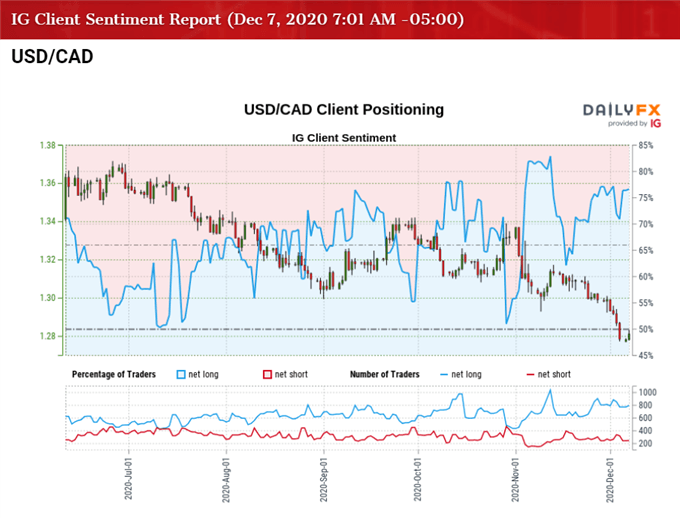Canadian Dollar Talking Points
USD/CAD attempts to retrace the decline following Canada’s Employment report, but the Bank of Canada (BoC) interest rate decision may keep the exchange rate under pressure as the central bank scales back its emergency measures ahead of 2021.
USD/CAD Rebound Vulnerable Ahead of BoC as RSI Sits in Oversold Zone
USD/CAD bounces back from a fresh monthly yearly low (1.2770) ahead of the BoC’s last meeting for 2020 as the US Dollar appreciates on the back of waning investor confidence, but the exchange rate may extend the series of lower highs and lows from the start of the month as the Relative Strength Index (RSI) tracks the downward trend from November and sits in oversold territory for the first time since June.

Looking ahead, the BoC is expected to keep the benchmark interest rate at the record low of 0.25% on December 9 as the central bank adjusts its quantitative easing (QE) program, with Governor Tiff Macklem and Co. announcing that “total purchases will be gradually reduced to at least $4 billion a week” as the board plans to shift its QE program towards longer-term bonds.
In turn, the BoC may largely endorse a wait-and-see approach going into 2021 as the central bank insists that the “QE program will continue until the recovery is well underway,” and key market trends may continue to influence USD/CAD as the Federal Reserve vows to “increase its holdings of Treasury securities and agency mortgage-backed securities at least at the current pace.”

At the same time, the tilt in retail sentiment also looks poised to persist as traders have been net-long USD/CAD since mid-May, with the IG Client Sentiment report showing 77.80% of traders still net-long the pair as the ratio of traders long to short stands at 3.50 to 1.
The number of traders net-long is 13.15% higher than yesterday and 8.22% higher from last week, while the number of traders net-short is 4.20% higher than yesterday and 21.02% lower from last week. The decline in net-short position could be a function of profit-taking behavior as USD/CAD bounces back from a fresh monthly yearly low (1.2770), but the rise in net-long interest has spurred a further tilt in retail sentiment as 72.49% of traders were net-long the pair during the previous week.
With that said, key market trends may keep USD/CAD under pressure as the US Dollar continues to reflect an inverse relationship with investor confidence, and the exchange rate may extend the series of lower highs and lows from the previous week as the Relative Strength Index (RSI) tracks the downward trend from November and sits in oversold territory for the first time since June.



USD/CAD Rate Daily Chart

Source: Trading View
- Keep in mind, the USD/CAD correction from the 2020 high (1.4667) managed to fill the price gap from March, with the decline in the exchange rate pushing the Relative Strength Index (RSI) into oversold territory in June.
- USD/CAD tracked the June range throughout July as the RSI broke out of a downward trend, but the failed attempt to push back above the 1.3440 (23.6% expansion) to 1.3460 (61.8% retracement) region led to a break of the March/June low (1.3315) even though the momentum indicator failed to push into oversold territory.
- The decline from the August high (1.3451) briefly pushed the RSI below 30, but lacked the momentum to produce a test of the January low (1.2957) as the indicator failed to reflect the extreme reading in June.
- In turn, the advance from the September low (1.2994) pushed USD/CAD above the 50-Day SMA (1.3120) for the first time since May, but the exchange rate reversed coursed following the failed attempt to test the August high (1.3451), which largely lines up with the 1.3440 (23.6% expansion) to 1.3460 (61.8% retracement) region.
- A similar scenario took shape in October as USD/CAD tracked the September range, but the exchange rate cleared the January low (1.2957) following the US election to trade to a fresh 2020 low (1.2923) in November.
- USD/CAD remains under pressure in December as the RSI continues to track the downward trend established in November and pushes into oversold territory for the first time since June, with the exchange rate carving a series of lower highs and lows since the start of the month to trade to fresh yearly lows (1.2770).
- USD/CAD attempts to retrace the decline from the previous week amid the failed attempts to break/close below the 1.2770 (38.2% expansion) region, but the recent rebound in the exchange rate may end up being short lived as long as the RSI holds below 30 and sits in oversold territory.
- Need a break/close below 1.2770 (38.2% expansion) to bring the 1.2620 (50% retracement) area on the radar, with the next region of interest coming in around 1.2490 (161.8% expansion) to 1.2510 (78.6% retracement).



--- Written by David Song, Currency Strategist
Follow me on Twitter at @DavidJSong





